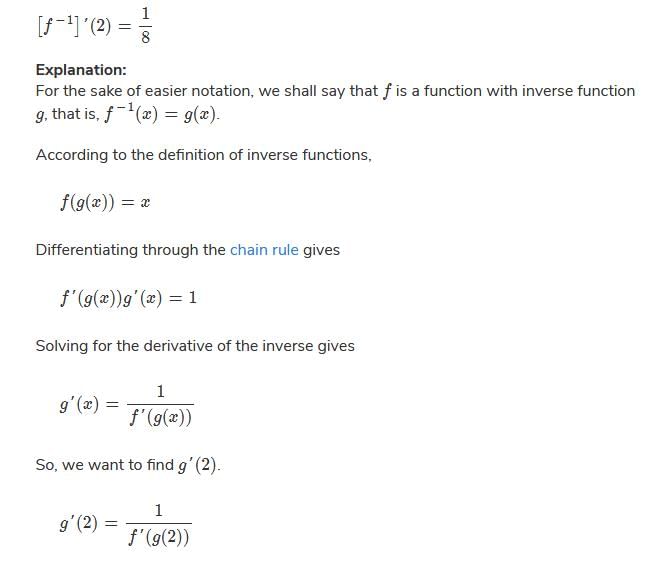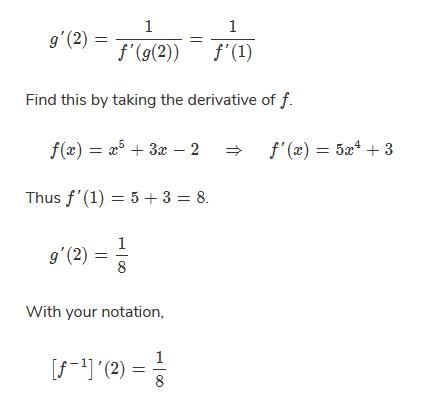Mathematics Exam > Mathematics Questions > Let f(x) = x3 + x and g(x) = x3 – x for...
Start Learning for Free
Let f(x) = x3 + x and g(x) = x3 – x for all x ∈ R. If f–1 denotes the inverse function of f, then the derivative of the composite function g o f–1 at the point 2 is
- a)2/13
- b)1/2
- c)11/13
- d)11/4
Correct answer is option 'B'. Can you explain this answer?
| FREE This question is part of | Download PDF Attempt this Test |
Verified Answer
Let f(x) = x3 + x and g(x) = x3 – x for all x ∈R. If fR...
Ans.
Method to Solve :



Most Upvoted Answer
Let f(x) = x3 + x and g(x) = x3 – x for all x ∈R. If fR...
Given:
- Function f(x) = x^3 - x
- Function g(x) = x^3 - x
- f1 denotes the inverse function of f
To find:
- The derivative of the composite function g o f1 at the point 2
Solution:
Step 1: Find the inverse of f(x)
To find the inverse of f(x), we need to interchange x and y and solve for y.
Let y = f(x)
Then, x = f1(y)
x = y^3 - y
Rearranging the equation, we get:
y^3 - y - x = 0
Now, we solve this cubic equation for y. There are different methods to solve cubic equations, such as factoring, synthetic division, or using the cubic formula. Let's use the rational root theorem to find a rational root of the equation.
The rational root theorem states that if a polynomial equation has a rational root, it can be expressed as the quotient of two integers, where the numerator divides the constant term and the denominator divides the leading coefficient.
In our equation, the constant term is -x and the leading coefficient is 1. Therefore, the rational roots can be expressed as:
y = ±factor of x / factor of 1
The factors of x are ±1 and the factors of 1 are ±1.
So, the possible rational roots are ±1.
By substituting these values into the equation, we find that y = 1 is a root of the equation. Therefore, (y - 1) is a factor of the equation.
Using polynomial division, we divide the equation by (y - 1) to find the other two roots.
(y^3 - y - x) / (y - 1) = y^2 + y + x + 1
Since y = 1 is a root, y^2 + y + x + 1 = 0 when y = 1.
So, (y - 1)(y^2 + y + x + 1) = 0
The quadratic factor can be written as a perfect square trinomial: (y + 1/2)^2 + (x + 3/4) - 17/16 = 0
Simplifying, we have (y + 1/2)^2 = 17/16 - (x + 3/4)
Taking the square root, we get:
y + 1/2 = ±sqrt(17/16 - (x + 3/4))
Subtracting 1/2 from both sides, we have:
y = -1/2 ± sqrt(17/16 - (x + 3/4))
So, the inverse function f1(x) is given by:
f1(x) = -1/2 ± sqrt(17/16 - (x + 3/4))
Step 2: Find the composite function g o f1(x)
The composite function g o f1(x) is obtained by substituting f1(x) into g(x).
g o f1(x) = g(f1(x))
= (f1(x))^3 - f1(x)
= (-1/2 ± sqrt(17/16 - (x + 3/4)))^3 - (-1/2 ±
- Function f(x) = x^3 - x
- Function g(x) = x^3 - x
- f1 denotes the inverse function of f
To find:
- The derivative of the composite function g o f1 at the point 2
Solution:
Step 1: Find the inverse of f(x)
To find the inverse of f(x), we need to interchange x and y and solve for y.
Let y = f(x)
Then, x = f1(y)
x = y^3 - y
Rearranging the equation, we get:
y^3 - y - x = 0
Now, we solve this cubic equation for y. There are different methods to solve cubic equations, such as factoring, synthetic division, or using the cubic formula. Let's use the rational root theorem to find a rational root of the equation.
The rational root theorem states that if a polynomial equation has a rational root, it can be expressed as the quotient of two integers, where the numerator divides the constant term and the denominator divides the leading coefficient.
In our equation, the constant term is -x and the leading coefficient is 1. Therefore, the rational roots can be expressed as:
y = ±factor of x / factor of 1
The factors of x are ±1 and the factors of 1 are ±1.
So, the possible rational roots are ±1.
By substituting these values into the equation, we find that y = 1 is a root of the equation. Therefore, (y - 1) is a factor of the equation.
Using polynomial division, we divide the equation by (y - 1) to find the other two roots.
(y^3 - y - x) / (y - 1) = y^2 + y + x + 1
Since y = 1 is a root, y^2 + y + x + 1 = 0 when y = 1.
So, (y - 1)(y^2 + y + x + 1) = 0
The quadratic factor can be written as a perfect square trinomial: (y + 1/2)^2 + (x + 3/4) - 17/16 = 0
Simplifying, we have (y + 1/2)^2 = 17/16 - (x + 3/4)
Taking the square root, we get:
y + 1/2 = ±sqrt(17/16 - (x + 3/4))
Subtracting 1/2 from both sides, we have:
y = -1/2 ± sqrt(17/16 - (x + 3/4))
So, the inverse function f1(x) is given by:
f1(x) = -1/2 ± sqrt(17/16 - (x + 3/4))
Step 2: Find the composite function g o f1(x)
The composite function g o f1(x) is obtained by substituting f1(x) into g(x).
g o f1(x) = g(f1(x))
= (f1(x))^3 - f1(x)
= (-1/2 ± sqrt(17/16 - (x + 3/4)))^3 - (-1/2 ±

|
Explore Courses for Mathematics exam
|

|
Similar Mathematics Doubts
Let f(x) = x3 + x and g(x) = x3 – x for all x ∈R. If f–1 denotes the inverse function of f, then the derivative of the composite function g o f–1 at the point 2 isa)2/13b)1/2c)11/13d)11/4Correct answer is option 'B'. Can you explain this answer?
Question Description
Let f(x) = x3 + x and g(x) = x3 – x for all x ∈R. If f–1 denotes the inverse function of f, then the derivative of the composite function g o f–1 at the point 2 isa)2/13b)1/2c)11/13d)11/4Correct answer is option 'B'. Can you explain this answer? for Mathematics 2024 is part of Mathematics preparation. The Question and answers have been prepared according to the Mathematics exam syllabus. Information about Let f(x) = x3 + x and g(x) = x3 – x for all x ∈R. If f–1 denotes the inverse function of f, then the derivative of the composite function g o f–1 at the point 2 isa)2/13b)1/2c)11/13d)11/4Correct answer is option 'B'. Can you explain this answer? covers all topics & solutions for Mathematics 2024 Exam. Find important definitions, questions, meanings, examples, exercises and tests below for Let f(x) = x3 + x and g(x) = x3 – x for all x ∈R. If f–1 denotes the inverse function of f, then the derivative of the composite function g o f–1 at the point 2 isa)2/13b)1/2c)11/13d)11/4Correct answer is option 'B'. Can you explain this answer?.
Let f(x) = x3 + x and g(x) = x3 – x for all x ∈R. If f–1 denotes the inverse function of f, then the derivative of the composite function g o f–1 at the point 2 isa)2/13b)1/2c)11/13d)11/4Correct answer is option 'B'. Can you explain this answer? for Mathematics 2024 is part of Mathematics preparation. The Question and answers have been prepared according to the Mathematics exam syllabus. Information about Let f(x) = x3 + x and g(x) = x3 – x for all x ∈R. If f–1 denotes the inverse function of f, then the derivative of the composite function g o f–1 at the point 2 isa)2/13b)1/2c)11/13d)11/4Correct answer is option 'B'. Can you explain this answer? covers all topics & solutions for Mathematics 2024 Exam. Find important definitions, questions, meanings, examples, exercises and tests below for Let f(x) = x3 + x and g(x) = x3 – x for all x ∈R. If f–1 denotes the inverse function of f, then the derivative of the composite function g o f–1 at the point 2 isa)2/13b)1/2c)11/13d)11/4Correct answer is option 'B'. Can you explain this answer?.
Solutions for Let f(x) = x3 + x and g(x) = x3 – x for all x ∈R. If f–1 denotes the inverse function of f, then the derivative of the composite function g o f–1 at the point 2 isa)2/13b)1/2c)11/13d)11/4Correct answer is option 'B'. Can you explain this answer? in English & in Hindi are available as part of our courses for Mathematics.
Download more important topics, notes, lectures and mock test series for Mathematics Exam by signing up for free.
Here you can find the meaning of Let f(x) = x3 + x and g(x) = x3 – x for all x ∈R. If f–1 denotes the inverse function of f, then the derivative of the composite function g o f–1 at the point 2 isa)2/13b)1/2c)11/13d)11/4Correct answer is option 'B'. Can you explain this answer? defined & explained in the simplest way possible. Besides giving the explanation of
Let f(x) = x3 + x and g(x) = x3 – x for all x ∈R. If f–1 denotes the inverse function of f, then the derivative of the composite function g o f–1 at the point 2 isa)2/13b)1/2c)11/13d)11/4Correct answer is option 'B'. Can you explain this answer?, a detailed solution for Let f(x) = x3 + x and g(x) = x3 – x for all x ∈R. If f–1 denotes the inverse function of f, then the derivative of the composite function g o f–1 at the point 2 isa)2/13b)1/2c)11/13d)11/4Correct answer is option 'B'. Can you explain this answer? has been provided alongside types of Let f(x) = x3 + x and g(x) = x3 – x for all x ∈R. If f–1 denotes the inverse function of f, then the derivative of the composite function g o f–1 at the point 2 isa)2/13b)1/2c)11/13d)11/4Correct answer is option 'B'. Can you explain this answer? theory, EduRev gives you an
ample number of questions to practice Let f(x) = x3 + x and g(x) = x3 – x for all x ∈R. If f–1 denotes the inverse function of f, then the derivative of the composite function g o f–1 at the point 2 isa)2/13b)1/2c)11/13d)11/4Correct answer is option 'B'. Can you explain this answer? tests, examples and also practice Mathematics tests.

|
Explore Courses for Mathematics exam
|

|
Suggested Free Tests
Signup for Free!
Signup to see your scores go up within 7 days! Learn & Practice with 1000+ FREE Notes, Videos & Tests.


















